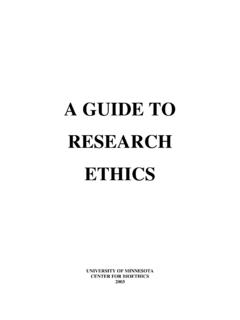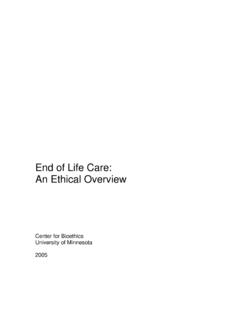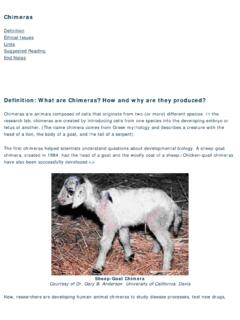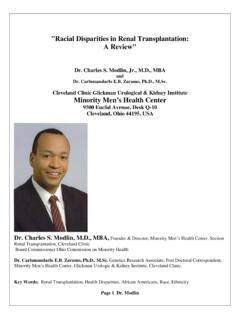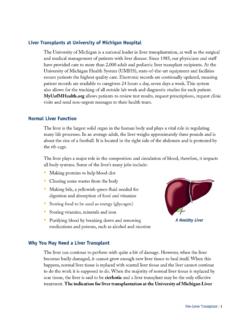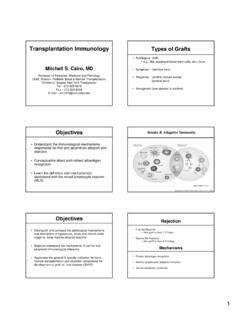Transcription of Ethics of Organ Transplantation - University of Minnesota
1 Ethics ofOrgan TransplantationCenter for BioethicsFebruary 200423 TABLE OF CONTENTSMEDICAL ISSUESWhat is Organ Transplantation ? ..Page 5 The transplant process ..Page 6 Distributing cadaveric organs ..Page 7A history of Organ Transplantation ..Page 9 Timeline of medical and legal advances in Organ 10 ETHICAL ISSUESE thical Issues Part I: The Organ 13 Distribution of available organs ..Page 15 Current distribution policy ..Page 17 Organ shortage ethical questions ..Page 19 Ethical Issues Part II: Donor Organs ..Page 20 Cadaveric Organ donation ..Page 20 Living Organ donation ..Page 24 Alternative organs ..Page 27 LEGAL AND SOCIAL ISSUESC urrent laws ..Page 29 The impact of Transplantation ..Page 31 OTHER MATERIALSB ooks and articles ..Page 33 Glossary ..Page 39 References ..Page 4145 MEDICAL ISSUESWhat is Organ Transplantation ?An Organ transplant is a surgical operationwhere a failing or damaged Organ in the human body isremoved and replaced with a new one.
2 An Organ is amass of specialized cells and tissues that work togetherto perform a function in the body. The heart is anexample of an Organ . It is made up of tissues and cellsthat all work together to perform the function ofpumping blood through the human part of the body that performs a specializedfunction is an Organ . Therefore eyes are organs becausetheir specialized function is to see, skin is an organbecause its function is to protect and regulate the body,and the liver is an Organ that functions to remove wastefrom the graft is similar to a transplant. It is theprocess of removing tissue from one part of a person sbody (or another person s body) and surgically re-implanting it to replace or compensate for damagedtissue. Grafting is different from Transplantation becauseit does not remove and replace an entire Organ , butrather only a all organs are transplanted.
3 The term Organ transplant typically refers totransplants of the solid organs: heart, lungs, kidneys, liver, pancreas and and artificial organs may also serve as transplantable organs. Other types oftransplants that are less invasive or may require specialized procedures, include: Skin transplants or grafts Corneal transplants (corneas are the outer layer of the eye) Bone marrow transplantsWHAT ARE ORGANS?Solid transplantableorgans: Heart Lungs Liver Pancreas IntestinesOther organs: Eyes, ear & nose Skin Bladder Nerves Brain and spinalcord Skeleton Gall bladder Stomach Mouth & tongue Muscles6 CADAVERIC ORGANDONATIONO rgans taken fromdeceased people arecalled is Latin for a dead body. **Janet sat alone in her hospital room with her covers drawn up under herchin. She stared at a blank television screen and rolled over in her mindfragments of the doctor s words.
4 Liver damage. She tried to shut her eyes to the question that was trying toforce its way into her thoughts. Powerless to hold them back any longer,the words came out. Why me? Tears welled and fell down her face,but they did not provide comfort.**The transplant processWhen a person falls ill because one of his or her organs is failing, or because theorgan has been damaged in an accident or by disease, the doctor first assesses whether theperson is medically eligible for a transplant. If so, the doctor then refers the individual toa local transplant center. The transplant center evaluates the patient s health and mentalstatus as well as the level of social support to see if the person is a viable candidate for anorgan transplant. If the patient is a transplant candidate a donor Organ must be are two sources for donor organs. The first source for organs removes themfrom recently deceased people.
5 These organs are called cadaveric organs. A personbecomes a cadaveric Organ donor by indicating that they would like to be an Organ donorwhen they die. This decision can be expressed either on a driver s license or in a healthcare directive. In Minnesota , designating your Organ donation desires on a drivers licenseis legally In some states, when a person dies and he or shehas not indicated Organ donation preferences, the familyis asked if they would be willing to donate theirrelatives organs. Some states hospitals have policiesrequiring family consent for Organ removal, regardlessof whether Organ donation wishes are written , many Organ donation advocacy organizationsencourage people to discuss their Organ donationpreferences with their families to assure that their wishesare known and ORGANDONATIONL iving people who wish todonate their organs candonate in two ways:1.
6 Donate one-half of apaired Organ : Kidney2. Donate a portion of anorgan that will still beable to functionwithout : A portionof the : A lobe ofthe lungThe second source for donor organs is a living person. Living donors are oftenrelated to the patient, but that is not always the case. Spouses and close friendsfrequently donate organs to ailing loved people who wish to donate their organsmay decide to donate to a stranger. A few not-for-profitorganizations maintain lists of willing living example, the National Marrow Donor Programmaintains a list of people willing to donate bone marrowto a stranger and there are a variety of non-related livingkidney donor organizations that maintain regional listsof willing who wish to donate one of theirorgans to a stranger may also initiate a nondirecteddonation (NDD). Nondirected donors approach either atransplant center or a nationally sponsored organprocurement organization and offer one of their organsfor transplant to anyone who may need cadaveric organsIf a person does not have a readily available living donor or is ineligible for aliving donation because their predicted outcome is questionable, they are placed into awaiting pool for an Organ from a cadaver by their transplant center.
7 The United Networkfor Organ Sharing (UNOS) maintains the list for the national waiting donor organs become available after a person dies an Organ procurementorganization (OPO) takes the organs into custody. The OPO then matches the donororgans with the appropriate transplant patients by gathering information about the donororgans and entering it into a computer program. The program takes this information andcompares it to information about the patients in the waiting pool. The computer thengenerates a ranked list of transplant patients who can receive the donor that factors into this ranked list include: Organ type, blood type and Organ size Distance from the donor Organ to the patient Level of medical urgency (not considered for lung transplant candidates) Time on the waiting list58 After the generation of the ranked list, the donated Organ is offered to the firstpatient s transplant center.
8 However, the first person on the ranked list may not receivethe Organ . Additional factors to be evaluated before the Organ procurement organizationselects the appropriate candidate are: Is the patient available and willing to be transplanted immediately? Is the patient healthy enough to be transplanted?Once the appropriate candidate is located, the Organ procurement organizationtakes the Organ and delivers it to the transplant center where the transplant will beperformed. This entire process must occur very quickly as organs are only transplantablefor a short time period after they ve been the transplant patient is ready for the donor Organ , the transplant center thensurgically removes and replaces the failed or failing Organ through the following generalprocedure:1. Make an incision in the body near the failing organ2. Cut the arteries and veins that run to the organ3.
9 Remove the Organ through the incision4. Take the new Organ and insert it into the body through the incision5. Connect the new Organ to the arteries and veins6. Close the incisionAfter the transplant, the patient embarks on a long road to recovery. If surgerygoes well, the patient still must face the possibility of rejection. Rejection is the processwhere the body fights off the newly implanted is harmful to transplant success because the body fights off the neworgan as it would a virus or bacteria. In fact, the body s immune system treats the organas it would any other harmful foreign invader. The immune system makes proteins calledantibodies that go to the transplanted Organ and try to kill order to hold back the antibodies that threaten the new Organ , transplantpatients have to take powerful immunosuppressant drugs to keep the level of antibodiesdown low enough for the Organ to integrate into the body and start A history of Organ transplantationThe medical practice of Organ Transplantation has grown by leaps and bounds overthe last 50 years.
10 The major transplant-related medical advances in the last centuryinclude: Successful Transplantation of different kinds of organsWhat began with the kidney has now expanded to hearts, lungs, liversand other organs. Development of cadaveric and living Organ donation practicesDeciding who can donate organs has been a flexible and changingprocess, starting with living donors and then moving to include deceasedand brain dead donors. The debate about increasing and restricting thepool of eligible donors continues 2001, living donors outnumbered cadaveric donors for the first time inUnited States Development of anti-rejection drugs to increase successAnti-rejection drugs have done wonders to increase the success of organtransplants. During the 1960s and 1970s, immunosuppressant drugshelped increase the success rate of Organ the 1980s, Cyclosporine was discovered and dramatically improvedthe success rate for transplant recipients and helped improve Using animal organs for human Transplantation (called xenotransplantation)In 1986, the first xenotransplanted Organ transplant was performed.
